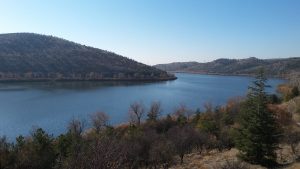Lake Eymir, located 20 km south of Ankara city center is included in the campus area of Middle East Technical University (METU). Before Lake Eymir was formed, the area was part of a pit valley following Mogan-Eymir-Incesu River which was formed by tectonic activities. During the beginning of the 20th century, due to the deposition of alluviums into the pit valley, Eymir and Mogan parts were cut off and Eymir and Mogan lakes were formed, the filled part is known today as Gölbaşı. Both lakes are part of same watershed and the water flow is in the direction of Lake Mogan to Lake Eymir since Lake Mogan’s elevation head is 3 meters higher.

Untreated wastewater of Gölbaşı town had been discharged to Lake Eymir between 1970s and 1995. As a result of that discharge, the nutrient concentration had increased dramatically. This was followed by a dramatic increase in phytoplankton concentration which caused the deficiency in oxygen concentration in Lake Eymir. As the oxygen concentration dropped, fish deaths had increased. This event is called eutrophication or disruption of food chain.
During these times Lake Eymir was also used to supply freshwater to METU campus. Due to all the discharge and the eutrophication event, the water had become unsanitary. To solve this issue, the academic staff of METU and the ASKİ (Ankara Water and Sewage Works) collaborated to stop the direct discharge of wastewater.
Although the discharge was controlled, the nutrients had already been accumulated in the bottom parts of the lake so the eutrophic nature of the lake is did not change. To solve this issue, lake restoration by bio-manipulation was applied. In this method, the fish types that had increased in number due to the pollution were detected and selectively fished in a controlled manner. During the restoration period, carp and doctor fish population decreased by 50%. As a result of the event, the in-water plants covered more area (which is a significant parameter of water quality). Not only quantitative change was observed also, some plants that can only live in very clean (pristine) waters were also started to be observed. Those changes lead to an increase in number of the birds as well.
However, due to the drought period that started in 2003, the water level in Lake Eymir had dramatically decreased. With the water level drop, the ingrained nutrients at the bottom layer started to mix with lake. All of this resulted in an increase in the number of phytoplanktons and cyanobacteria. The salinity of the lake also started to increase in that period because as the water level dropped, the outflow of the lake also decreased. To remedy the disturbed ecological status, a second bio-manipulation study is currently ongoing, showing promising results in water quality.
During wet periods, with increasing retention time, the eutrophic burden on the lake is relaxed and biodiversity increases. The stark difference between wet and dry periods can be considered to be a preview of problems due to global warming.